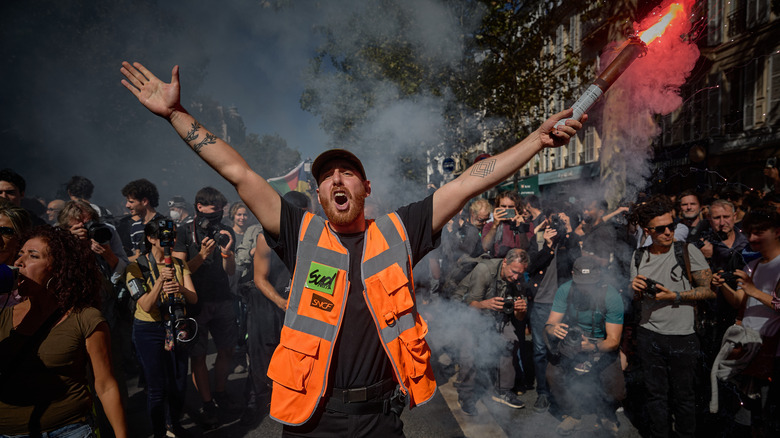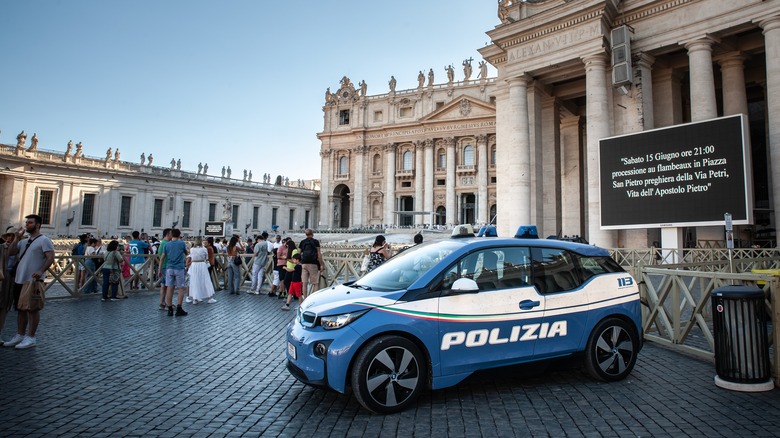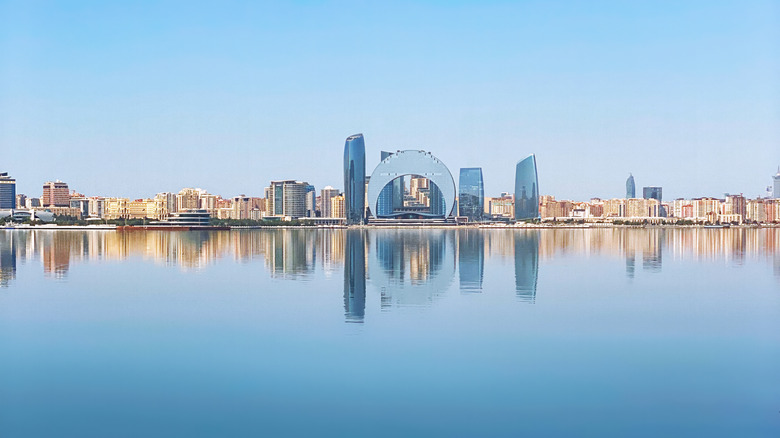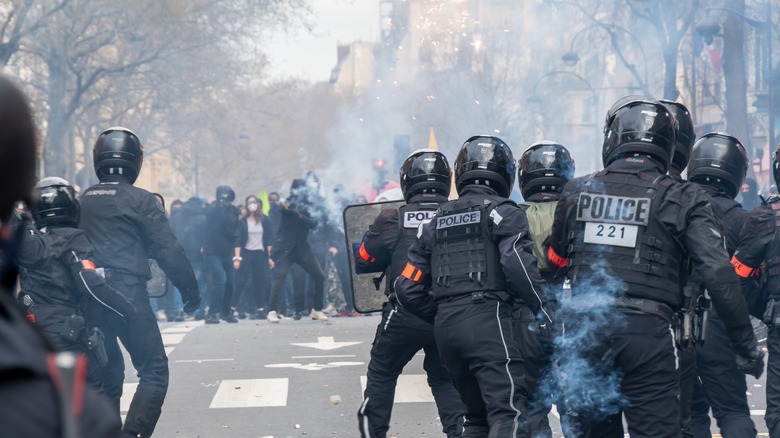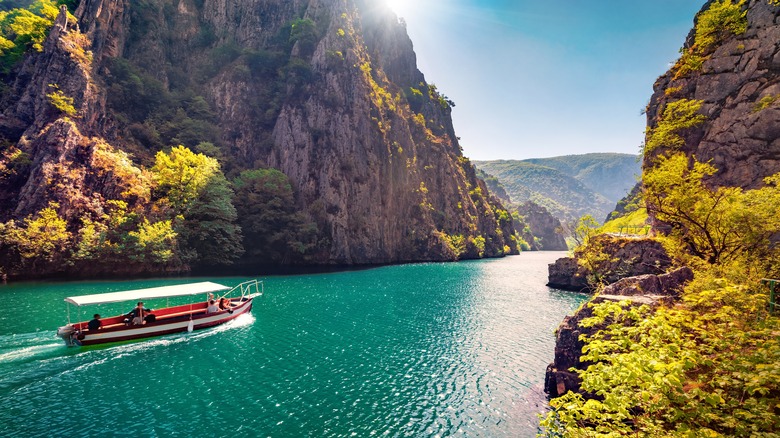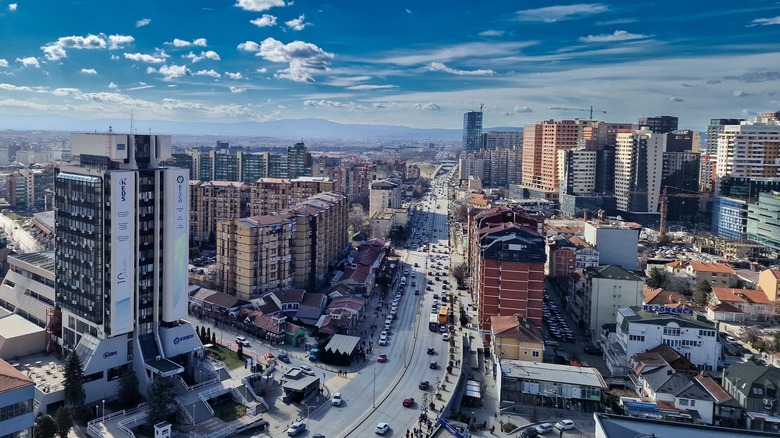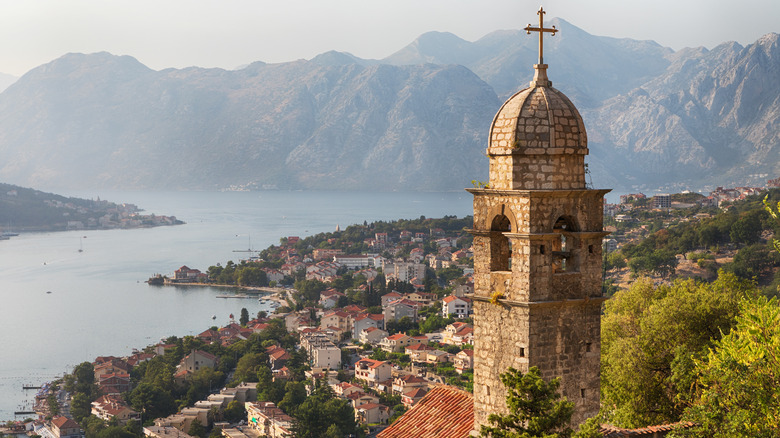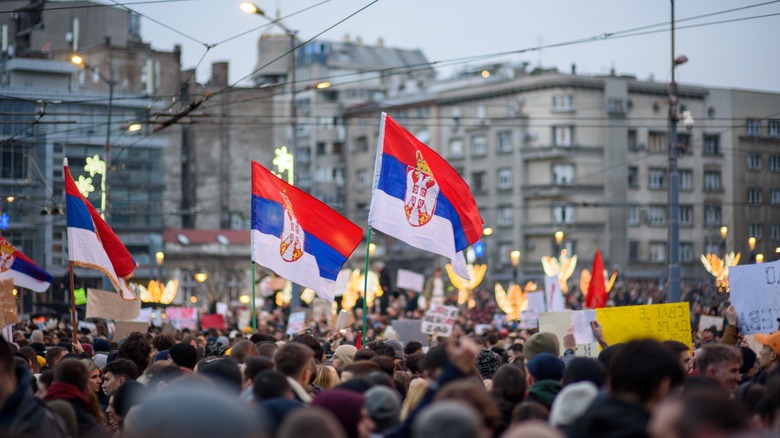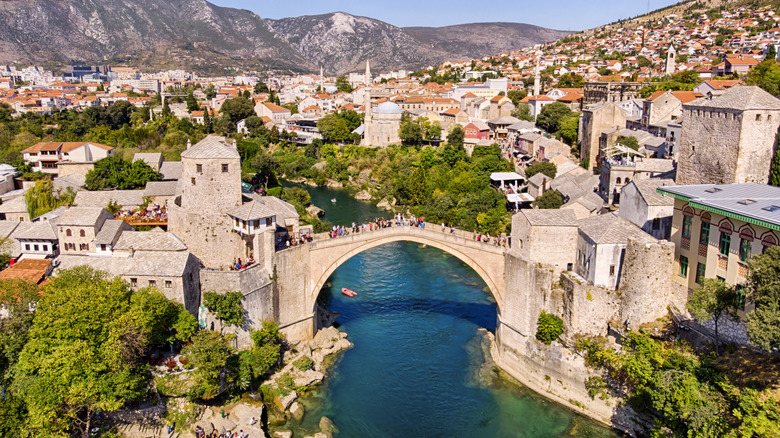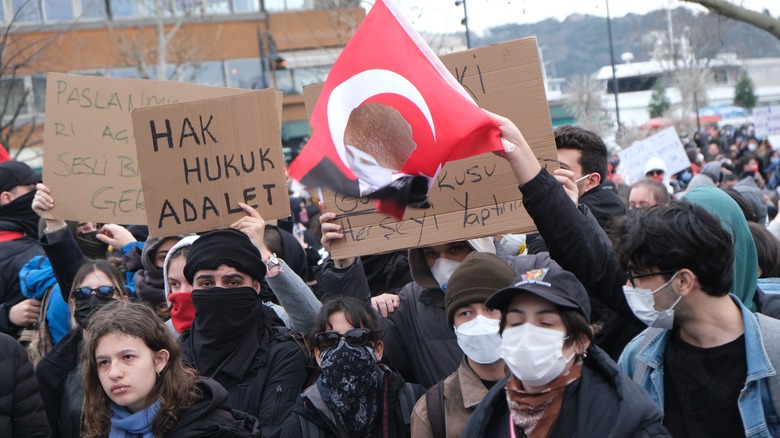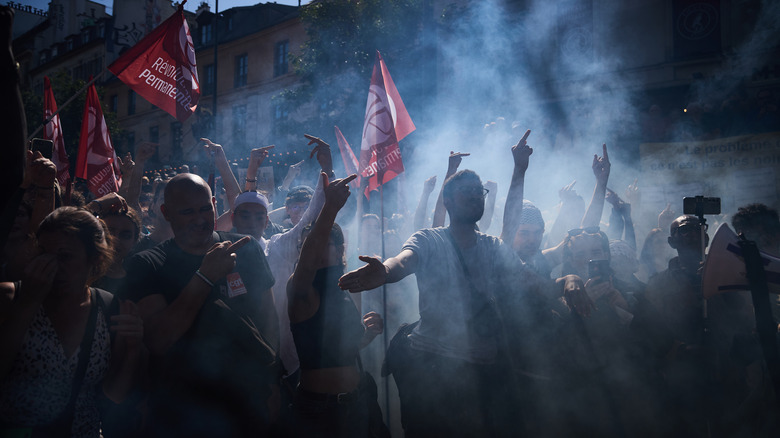The Most Dangerous Countries To Visit In Europe Right Now
Danger is one of those words that is difficult to define. Crossing the road entails risk; the chance of injury or death is extraordinarily low, but of course, there are a lot of roads, so fatalities do occur. Australia is filled with a menagerie of dangerous wildlife, and yet, only a few dozen deaths occur each year, mostly from people falling off horses. Lightning bolts strike, volcanoes erupt, and tires burst from underneath us.
Of course, most of us are more than capable of a degree of risk assessment. We visit dangerous places with the understanding that anyone following the safety instructions really does not have much to worry about. The world's most shark-infested beaches, really, aren't visited by sharks all that often because they are well-patrolled and fatalities are rare. When traveling, we look for advisory warnings and seek recommendations online about where not to go. Most of us are lucky enough to pass through life unmolested by any seriously dangerous event.
Europe is, on balance, a very safe place indeed. The Global Peace Index (GPI) lists no fewer than seven European nations in its top ten; the United States comes in at a worrying 128th out of 163 countries. Still, there are areas of Europe that are more dangerous than others. Ukraine, Russia, and Belarus are obvious no-go areas right now, but political instability and the ever-present risk of crime are genuine causes for concern elsewhere. Ranking such places is no easy feat. The GPI is a helpful guide, but other metrics — such as the presence of organized crime, geography, and civil unrest — must be considered. Perspective, however, is a critical part of any risk assessment. Most, if not all, the places listed below are relatively safe to visit, provided you take appropriate precautions.
Italy
Italy is one of the most visited countries in the world and is so for a variety of reasons. Whether you are seeking the most breathtaking destinations in Tuscany, perusing the art galleries of Florence, or attempting to explore Italy on an extremely tight budget, the country provides and does with an unironic amount of gusto. It is, for the most part, a peaceful place, something reflected in its GPI placement of 33 out of 163 countries. Still, such a placement is relatively low, for a European nation. The question is, why?
Although the stereotype is due to obvious Hollywood exaggerations, it should be noted that Italy has had a historical reputation for organized crime. It's true that many things have changed over the years, but to suggest that Italy no longer has any significant issues with the Mafia whatsoever would do a disservice to the truth. Data-wise, things are clear: The Organized Crime Index (OCD) gives Italy a criminality score — an assessment of overall organized crime levels — of 6.22, which is well above the global average. Italy is a port of call for human traffickers, a hub of smuggling activity, and it's one of the worst places in Europe when it comes to counterfeit goods, according to the OCD. All of which is upsetting, but hardly fits the category of dangerous, at least not for tourists.
Once organized crime activities are taken out of the running, crime levels in Italy are only rated at a moderate level and vary greatly between regions. Naples, for example, has somewhat of a reputation for criminality, making it far less "safe" than Rome. Meanwhile the northern city of Verona is far enough away from the action that it remains one of the safer places you could visit in the country.
The Europe-Asia Fringe
Azerbaijan's location in the Southern Caucasus places it on the border between Asia and Europe. Its position on the west bank of the Caspian Sea — which few would deny is at least somewhat European — however, creates a definite ambiguity. Regardless, as a member of the Council of Europe, its political affiliation, at least, is agreed upon. With no fewer than three UNESCO World Heritage sites to explore, Azerbaijan is certainly worth a visit. The walled city of Baku, with its stunning palace, is a delight, its central region is littered with 40,00 year old rock art, and, at the foot of the Caucasus Mountains, you'll find the historic city of Sheki.
Neighboring Armenia's place in the Council of Europe also grants it a certain amount of geopolitical certainty. It was the first state to adopt Christianity as its official religion way back in 300 CE, a fact emphasized by many of the attractions across the nation. The unironically-named Amaghu Noravank (or New Monastery) has been in situ since the 13th century. Meanwhile, the rugged mountain terrain offers some not-for-the-faint-of-heart hike that can last up to 15 days as enthusiasts follow the path of the ancient Silk Road.
Of course, neither country is free from issues. A Level Two advisory warning is in place for both, and Azerbaijan's GPI score of 95 (via Global Finance) indicates a certain level of instability. A recent cessation of armed conflict in Armenia seems to be holding, and Armenia's GPI placement of 58 suggests it is far from the most hostile of places. Still, it is sparsely populated, and the wilderness is full of surprises. Anyone wishing to go to either country should double-check official sources to make sure there has been no change of status.
France
From the most luxurious hotels in Paris to the culinary delights of Lyon, France pulls in tourists from around the world. Indeed, every year, close to 100 million people make the trip, making it the most visited country on the planet (via Road Genius). Strange then, to find France so high up on a list like this.
To begin with, there are no Level Three plus travel advisory warnings in place here, no wars, and no elevated risk of gun violence. You are unlikely to be arrested for political dissent, there are no geopolitical sensitivities to watch out for, and you're not going to have to bribe any officials to gain a visa permit or access to emergency services. France is much safer than America: It ranks 74th on the GPI, which is a far cry from the U.S.' placement. Still, the relative safety of such measures makes France the fourth most dangerous country to travel to as of 2024, according to Hello Safe.
In terms of criminality, France is beaten out only by Belarus, a nation precluded from this list thanks to its Level Four travel advisory warning. It is definitely not safe to walk the streets of Paris at night. It's not very high up on the lists of safe countries for solo female travelers. And, you absolutely need to be aware of your surroundings when navigating metropolitan areas. The second issue of terrorism is less clear-cut. France's long history of intervention in Muslim countries has undoubtedly made it something of a target. According to the European Council, France arrests a disproportionate number of people on terrorism related events, and has suffered more attacks than Germany and Spain combined. Still, the chances of being involved in such an attack remain vanishingly small. Hence all the traffic.
North Macedonia
North Macedonia is a landlocked nation — and one of Europe's most affordable and underrated countries — surrounded by larger neighbors such as Greece, Albania, Bulgaria, and Serbia. It achieved independence in 1991, and despite the name, there is no South Macedonia since that region is now part of Greece. Its population of slightly over 2 million people makes it one of the least populated places in Europe. assuming you choose not to include the minuscule Vatican, San Marino, and Lichtenstein. It has low instances of street-level crime, and a visit to the Prespa Lakes — the highest freshwater bodies of water in the Balkans — is one of those secret retreats you have to see to believe. Meanwhile, Lake Ohrid, one of the world's oldest and deepest lakes, is only a two and a half hour drive to the capital, Skopje, a place filled with the incongruity of Ottoman bazars, ancient stone bridges, and Soviet-era monuments.
The issue here is organized crime. Human trafficking is a real problem: much of what occurs is for the purposes of labor exploitation, although a disturbing 70% of those trafficked are minors. Sex trafficking also occurs with North Macedonia, sometimes used as a jumping-off point into the rest of Europe. With such crime, comes violence, and the murder rate is shockingly high for a European country. Still, with a score of 1.53 homicides per 100,000 people (via World Population Review), it's less than a third of the U.S. murder rate (5.6 per 100,000), so again, a dash of perspective is required when assessing a trip. Such evaluations are especially poignant here because it truly is a magnificent place to spend a week or two over the summer.
Kosovo
It is, perhaps, a shame that so many of the countries on this list are under-the-radar tourist-friendly gems. Kosovo is yet another Balkan state that, like North Macedonia, finds itself landlocked. Its capital city, the superbly named Pristina, stands in proud testament to Europe's youngest country. Twenty years ago, Kosovo didn't exist, at least not as a political entity. After declaring independence from Serbia in 2008, the country set about forging a new path for itself, pitching towards a tourist economy that celebrated the history of the region, if not the burgeoning nation itself.
There's certainly plenty to see. Some 26 miles north of Pristina, you'll find the city of Mitrovica, famed for its Ottoman coffee houses, ancient churches, and pristine forests. The western provinces are home to the Accursed Mountains, which, despite the ominous-sounding name, are home to hidden pools, magnificent waterfalls, and some of the best walking holidays in Europe. Kosovo's largest lake — Gazivoda — is also high up on any list of recommendations. It's basically Lake Como at a fraction of the price and quieter in the summer months by half.
All that positivity, however, cannot hide some of the darker aspects of Kosovo's criminal underbelly. The organized crime found in North Macedonia has little respect for boundaries. Indeed, it's a problem seen across the whole Balkan region. Kosovo ranks at number 63 on the GPI, but although its criminal index score is the lowest found in the Western Balkan Six group of nations, its resistance to criminality remains low. The net result is that Kosovo maintains a Level Two travel advisory warning.
Montenegro
Montenegro is yet another Balkan state that deserves more attention than it gets. Like many of its neighbors, it is a place of rugged terrain perfect for those looking for a truly stunning hiking adventure. Indeed, you'll find yourself surrounded by dramatic lakes and mountains as you head into the wilderness and, if seeking adventure, get a chance to experience some of Europe's most beautiful rapids. There are golden eagles to spot and chalets to sleep over in on this side of the accursed mountains, or you can head north from the capital to enjoy a whole raft of winter sports. To top it all off, Montenegro has a magnificent coast, 175 miles of it, overlooking the Adriatic. It's as gorgeous as you'd expect and far cheaper than its Southern Italy equivalent.
Of course, its placement on this list suggests that the country is not without issues, although they certainly need unpacking. To start with, Montenegro ranks 34th on the GPI, slightly ahead of Sweden and only a little behind Norway. So, it's a peaceful enough place. Crime in its capital city is listed as moderate and has a high level of safety when it comes to walking alone at night. So, street crime isn't too bad either. The issue here, common to most if not all Balkan states, is organized crime. It is a major transit nexus for human trafficking and Mafia-style gangs such as the Skaljari and Kavac also use Montenegro as a port of call in the illicit drug trade. The knock-on effect of this is easy to miss, of course, and for obvious reasons, tourists rarely find themselves fact to face with such issues.
Serbia
Serbia is ranked 64 on the GPI, some 10 places below France, which appeared higher up on this list. Its criminality score is another matter entirely. Its score of 6.22 makes it the third worst in Europe, while its ability to combat such activity remains decidedly average. Human trafficking is as much a concern here as it is anywhere else in the region.
Once again, the scourge of organized crime rears its ugly head to blight an otherwise picturesque nation. In addition to the trade in people, extortion and loan sharks are common here, both crimes that tend to bypass the tourism industry. The nation is also a transitional hub for the heroin trade and all the associated violence it brings with it. It all adds up to a Level Two warning from the U.S. State Department, and their advice to exercise increased caution.
Still, the ever-present caveat of it being dangerous, but only by European standards, means that anyone exercising such caution is still liable to have a lovely time. The forested trails of the Fruška Gora National Park are simply perfect for cycling trips, while those wishing to explore Europe via the Danube would do well to begin their journey here. And, although the wide span of the Djerdap National Park makes it a must visit for outdoor adventure enthusiasts, the capital city of Belgrade, 82 miles to the west, is one of the best city break locations out there.
Bosnia and Herzegovina
Bosnia is something of an oddity, even by the unusual geography of the Baltic states. Its 12 miles of coastline is near invisible on a map, unless you know what you are looking for, but it's there, towards the south, close to the village of Neum. The dissolution of the former Yugoslav nations represented a dark chapter in European history, and the lines drawn often make little sense to the casual observer.
The U.S. has a Level Two travel advisory warning directed at those wishing to visit Bosnia and Herzegovina, and once again, the chief issues here are crime and terrorism. Some 30 years have passed since the end of the war, but military hardware endures. The western half of the Balkans is curiously well-armed for a European nation, and although violence between rival gangs is common, tourists are rarely targeted by such activities. Still, Bosnia and Herzegovina's GPI placement of 60th is indicative of the general milieu of intolerance. Political violence is also ubiquitous, and made worse by the presence of so many illegal weapons. To cap it all off, the government is ill-equipped to deal with the issue. Corruption lurks around every corner and Bosnia ranks 114 out of 180 when it comes to transparency on such matters (via Transparency International).
You would think that it would make it a difficult place to recommend, but I've traveled there twice. And, sure, anecdotes are not the plural of data, but the only thing I brought back with me were pleasant memories. The capital, Sarajevo, is a budget-friendly walkable paradise, while 100 or so miles to the northwest, you'll find one of Europe's most beautiful places, replete with towering waterfalls and emerald pools.
Turkey
There are many reasons why some 40 to 50 million people flock to Turkey (also known as Türkiye) every year. Some go to become immersed in its history. The country is home to the oldest known human settlement, it is the land where the Trojan War was fought, and in its capital, you can find preserved the might and majesty of the Roman Empire. For others, it's all about the beaches, the calm dignity of the Eastern Mediterranean, or the rugged ambience of its Black Sea coast. Foodies wallow in the ethnically diverse fare on offer, a mix of Kurdish, Arabic, Greek, and Armenian delicacies blended over millennia into something as unique as it is delicious. There are regions that will feel almost like you're in a storybook, as well as areas that are so ultra-modern that you'll forget you're staying on the fringes of Europe. It's a delight, to be sure.
Unfortunately, Turkey is also something of a land in turmoil. Crime, corruption, and political instability remain major roadblocks to continuing prosperity. Such issues are reflected by the country's dismal GPI rank of 146th — the worst in Europe, Ukraine, Russia, and Belarus aside, and the only nation on this list to perform worse than the United States. The level of crime you will find is moderate; tourist hotspots are notorious for pickpockets and scam artists, but that is, of course, hardly unique to Turkey. The State Department's Level Two warning makes note of the threat of terrorism, but also warns of arbitrary detentions. Corruption is a real problem here, much of it linked to organized crime. You are unlikely to have to bribe a law enforcement officer if you end up in a sticky situation, but to suggest it is unheard of would be a lie.
Methodology
This list was compiled by cross-referencing several data points with personal experiences. Rankings were heavily weighted towards Global Peace Index rankings, although some latitude was given towards other metrics, such as the prevalence of organized crime and data relating to internal corruption. If a traveler were to take a trip to any of these places, good personal judgement is encouraged. For example, is Serbia more dangerous than Montenegro? It's probably a close call. Personal experiences guided a path towards the final decision. Of course, as was stated earlier, few places on this list are truly all that dangerous and many people flock to such locations year after year. Many people have visited these locations without experiencing any major issues. Let common sense, proportionality, and a little research be your guide.
